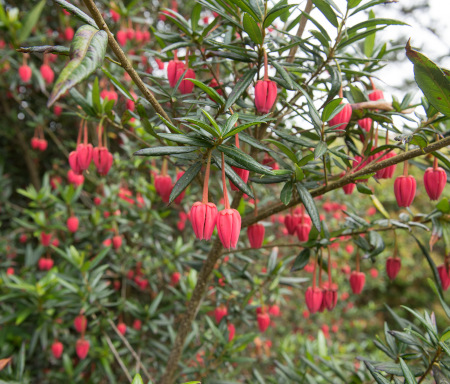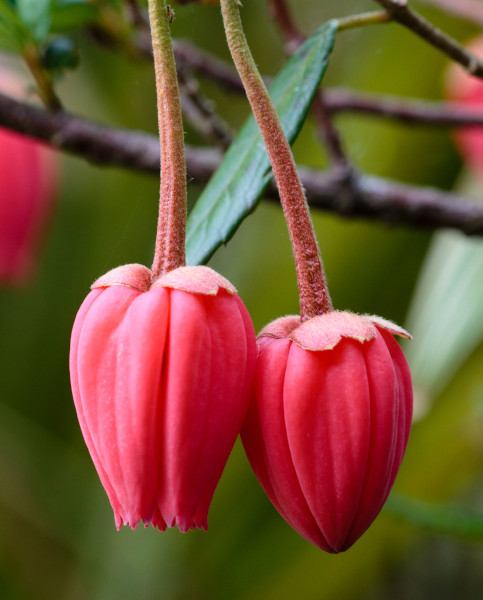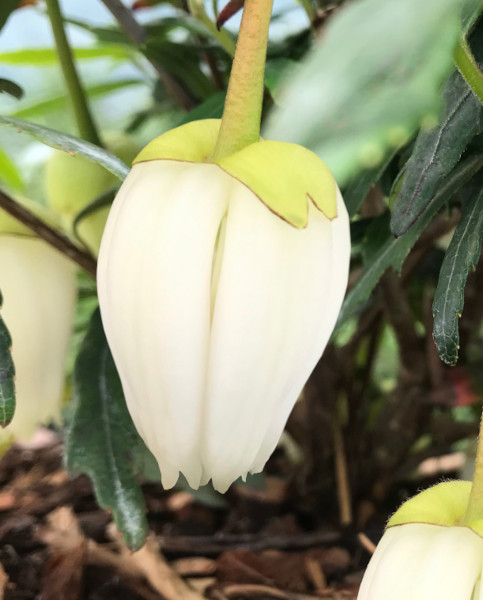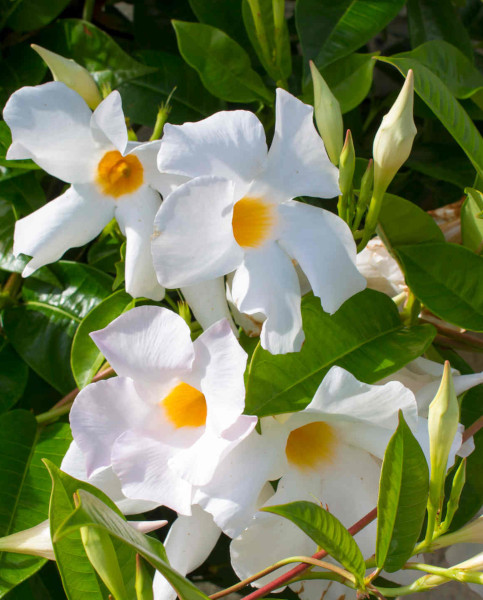How to grow Crinodendron

Crinodendron is one of the few hardy members of Elaeocarpaceae, a plant family of mainly tropical and subtropical evergreen trees and shrubs. There are two species of crinodendron, both found in forests in Chile. These grow as multi-stemmed shrubs or small trees, and are cultivated for their handsome evergreen foliage and pendulous flowers.
Most popularly grown in the UK is the slightly hardier of the two, Crinodendron hookerianum (along with its numerous cultivars). From late spring to late summer this can be seen dripping with lantern-shaped flowers, hence its common name of the Chilean lantern tree.
The other species, Crinodendron patagua (also known as lily of the valley tree), is a little more tender and has a reputation as being tricker to grow. It is therefore a far less common sight throughout UK gardens, though can make a beautiful conservatory or greenhouse plant.
Key Information
Soil pH
Position
Hardiness


Where to plant Crinodendron
For best results, plant in autumn or spring. An autumn planting is suitable for those gardening in mild conditions (broadly speaking, the southern half of the UK). For those liable to very cold winters it is best to wait until spring (generally the northern half of the UK). Planting can also be carried out during summer, though a watchful approach to watering is required.
The closer you can match sheltered, acidic, woodland origins of crinodendron, the more your plant will thrive. A woodland garden is ideal, as is against a sheltered wall. While partial shade is preferred, if you can keep roots cool and shaded (perhaps with a stone mulch, or by using lush, dense groundcover plants) full sun will be tolerated. In most of the UK, shelter from cold, drying winds is required, though in milder areas (i.e., coastal locations) an exposed spot will be okay.
If you do not have acidic soil in your garden, crinodendron can also be grown in a large container filled with ericaceous compost. This can be kept either outside or in a cool greenhouse or conservatory (in which case it will flower earlier).
How to plant Crinodendron
In the ground
- Clear the chosen area of weeds.
- Dig a planting hole several times larger than the root ball. If you are gardening on poor soil, it is a good idea to mix in some well-rotted organic matter at this stage. Avoid soil prone to winter waterlogging.
- Place the plant in the hole, ensuring the top of the root ball sits level with the surface of the soil. Too low and the plant may rot, too high and the roots can dry out.
- Backfill with soil and firm in gently.
- Soak well with water.
- Mulch around the base with well-rotted organic matter. Add plenty of stones or pebbles on top if you are planting it in full sun and need to keep the roots cool (see above).
In a container
- Choose an appropriate container (the bigger the better), ensuring there are plenty of drainage holes.
- Use a good quality ericaceous potting compost with plenty of horticultural grit mixed in, and, if not already present in the compost (check the description on the bag) some ericaceous plant food. Make sure this is slow release rather than dried granules. Dried granules are known to provide higher quantities of nutrients than crinodendron can cope with and are likely to cause harm.
- Start by partially filling the pot with compost; enough so that when placed on it the upper surface of the root ball is about 3cm lower than the top of the pot.
- Infill all the space surrounding the root ball with compost, firming down with your fingers then adding a little more so the plant is held tight.
- Pick up the pot (if you can!) and lightly tap on the potting bench or ground a few times to help further settle the compost around the plant.
- Soak well with water.
- A mulch with horticultural grit will look attractive and help to prevent a ‘cap’ or crust forming on the top of the compost (something container plants can suffer due to the artificial nature of their watering).

What to plant with Crinodendron
Gardens with acidic soil present an exciting opportunity to grow some of the most beautiful flowering shrubs there are. Try combining crinodendron with rhododendron, camellia, hydrangea, enkianthus and physocarpus. Underplant with delights such as vaccinium (blueberry), meconopsis, erythronium, and trillium, along with ferns such as blechnum and osmunda.
If you choose instead to grow your crinodendron as a greenhouse or conservatory plant, suggestions for indoor companions include strelizia, dipladenia, citrus and plumbago. An exotic and colourful paradise awaits!
If you would like any further planting ideas or growing advice for your crinodendron, please contact our friendly and knowledgeable Customer Care Team - we will be more than happy to help you.



How to care for Crinodendron
Pruning and Deadheading
Crinodendron is best left unpruned, apart from the removal of dead, diseased or damaged wood in spring.
Watering
Water well until established, and then in very dry spells thereafter.
Crinodendron grown in a container will require regular watering throughout the growing season. Allow the top few centimetres of compost to dry out between soakings.
Cold Protection
Crinodendron is hardy to between -5°C and -10°C, and if planted in a sheltered spot it should overwinter throughout most of the UK without the need for additional protection.
If you live in an area prone to very low winter temperatures, either plant your crinodendron against a sunny, south-facing wall or grow it in a container to enable relocation to a cool greenhouse or conservatory during winter. Another approach is to have it as a greenhouse or conservatory plant all year round.
Pests and Diseases
Crinodendron tends to be trouble-free.
How to propagate Crinodendron
Crinodendron can be propagated by cuttings taken during summer.
- Find non-flowering shoots 5-10cm long and snip off the plant.
- Put them in a plastic bag straight away to prevent drying out.
- Fill a container with a compost mix which is at least 50% perlite (or if you prefer, as we do, 100% perlite).
- Trim the end of the cutting to just below a node (point at which leaves grow).
- Remove the lowest third of leaves.
- If the remaining leaves are large, cut them in half with a sharp knife (to reduce water lost through transpiration).
- Insert the cuttings into the compost and water lightly. Several cuttings can be put in the same container if there is enough space to do this without them touching.
- Place in a greenhouse or propagating unit if you have one or covered with a plastic bag on a windowsill if not (out of direct sunlight).
- Keep the cuttings misted and occasionally watered until they root. You will know this has happened when roots emerge out of the bottom of the container.
- Gently remove rooted cuttings and pot them into individual pots. Grow on in a cool yet frost-free environment such as an unheated conservatory, greenhouse, or cold frame, until they are large enough to be planted out.
Common Crinodendron Questions:
Can you grow crinodendron in a pot?
Yes, you can. Using a container filled with ericaceous compost mix can be a good way for those without acidic soil to enjoy a crinodendron in their garden. As with all trees and shrubs, crinodendron grown in this way will remain smaller than those grown in the ground and require regular watering. See ‘How to plant crinodendron’ and ‘How to care for crinodendron’ for more details.
When should I prune crinodendron?
Aside from the removal of dead, diseased or damaged wood in the spring, crinodendron is best left unpruned.
Is crinodendron poisonous?
Contact with the sap of crinodendron can lead to skin inflammation, while ingesting parts of the plant can lead to gastrointestinal irritation. Seek medical advice if you have any concerns.
Why is my crinodendron struggling?
Crinodendron can be slow to establish, taking from 10-20 years to reach its eventual size. Two potential pitfalls to avoid, particularly when plants are young, are waterlogged conditions and the use of dry granular fertiliser. Crinodendron is known to respond to the surge in nutrients caused by the latter with excessive amounts of weak growth, often exhausting the plant and leading to rot. With a good annual ericaceous mulch (such as pine needle leaf mould), crinodendron grown in the ground should not require feeding. For container-grown crinodendron, mix in slow-release ericaceous feed every time you repot. Between this, apply a small amount of ericaceous liquid feed if ever the plant appears to be flagging.




